- Home
- Technical Cooperation Projects
- Index of Countries
- Africa
- Sudan
- Capacity Development Project for Provision of the Services for Basic Human Needs in Kassala
- Project News
- Toward effective Village Midwife in-service training – From the field of training of facilitators and teaching material development-
Project News
2014-03-17
Toward effective Village Midwife in-service training – From the field of training of facilitators and teaching material development-
As it has been introduced as "In-service training for Village Midwives" and "Coaching workshop for facilitators" on previous project news (See the links below), Health Cluster of Capacity Development Project for Provision of the Services for Basic Human Needs in Kassala (K-TOP) has implemented the capacity building of village midwives through in-service trainings and the improvement of coaching capacity of facilitators (Midwives called as Health Visitors).
Regarding the improvement of coaching capacity of Health Visitors, K-TOP Health Cluster team conducted two workshops on coaching and teaching material development, and developed job-sheets and flipchart style materials which later became the basis for the current teaching material. These materials were introduced into in-service trainings. Through evaluations on the use of the materials in those in-service trainings, we improved the content and the effective use of materials. After many discussions and efforts in another two workshops on coaching and teaching material development, current teaching materials were finalized.
However, once facilitators started to use job sheets which all facilitators developed together, the job sheets were not used in a uniform way. Therefore, we further discussed to decide on a uniform way on its use. Similarly, once facilitators started to use the lesson plan in the training, we found the contents were incomplete so that facilitators could not teach all key messages in the lecture. Moreover, a facilitator finished her lecture in 15 minutes even though the lecture was planned to be 60 minutes. For these reasons, it was necessary to develop a "standard" teaching material which all facilitators can agree and all facilitators can use unified way.
Thus, we decided to develop a model lesson plan by consolidating the best part of the lesson plan made by each facilitator. The model lesson plan includes all the points to be taught and suggestions on the best timing on using IEC (Information Education Communication) materials and time allocation. We also made questions and took adequate pictures for the flipchart materials. Through these activities, lesson plan, job-sheet and flipchart material were developed step by step. As a result, 5 topics (blood pressure measurement, urine test, preparation of delivery, conduction delivery and cleaning after delivery (include equipment sterilization)) job-sheets and flipchart, 15 topics of lesson plan were developed. Later job-sheets and lesson plans became one manual book of facilitation manual for VMW training and flipchart materials were completed.
Nonetheless, the development of teaching materials is not enough and the next step is how to use the developed teaching material in an efficient way. To ensure the effectiveness on the use of developed materials, we also trained facilitators through workshop on the effective use of the materials and practiced in in-service trainings.
We believe that only independent activity such as workshops on teaching material development or in-service trainings is not enough. In K-TOP, we provided workshops to strengthen facilitators' capacity, and then immediately after the workshops, the facilitators could practice their learning in village midwife in-service trainings. After the practices, JICA health cluster team and facilitators evaluated how it worked in the training, and then conducted workshop to improve the contents of the material and the technique on its use. This repeated cycle of activities led the development of effective material and guidance on the best method on its usage by facilitators.
In these three years, we included the facilitators as much as possible in this cycle, implementation of the trainings, workshops, and material development. The active involvement of the facilitators and their ownership of the process led each facilitator to be confident in teaching and built teamwork between facilitators.
In a situation of Kassala which most of village midwives are illiterate, in order to improve the quality of in-service trainings, it is important to develop visualized teaching materials and to train facilitators to let them to use teaching materials effectively. These teaching materials developed in Kassala state were acknowledged by Federal Ministry of Health, and the materials will be used for not only village midwife in-service trainings but also in the future basic trainings of village midwives. I hope that these developed materials through trial and error will be used in the field of village midwife education in Kassala and the other states, and they will contribute to safe and comfortable maternal and child health services in Sudan.
(Reported by Ms. Kiyoe Ito, JICA Expert on Maternal and Child Health (Training Management))
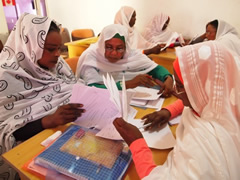 Group work on the development of lesson plan.
Group work on the development of lesson plan.
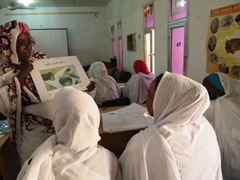 Practice on the effective use of how flipchart materials.
Practice on the effective use of how flipchart materials.
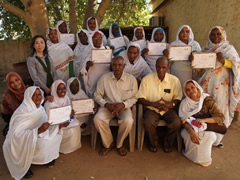 Lecturer from Federal Ministry of Health and Facilitators.
Lecturer from Federal Ministry of Health and Facilitators.
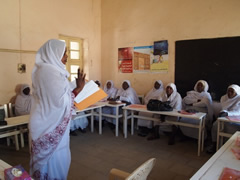 A facilitator used the developed lesson plan in an in-service training.
A facilitator used the developed lesson plan in an in-service training.
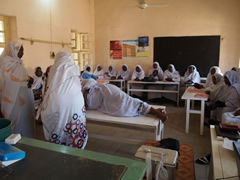 Facilitators introduced Role Play on post natal care in an in-service training.
Facilitators introduced Role Play on post natal care in an in-service training.
- About JICA
- News & Features
- Countries & Regions
- Our Work
- Thematic Issues
- Types of Assistance
- Partnerships with Other Development Partners
- Climate Change / Environmental and Social Considerations
- Evaluations
- Compliance and Anti-corruption
- Science and Technology Cooperation on Global Issues
- Research
- JICA Development Studies Program / JICA Chair
- Support for the Acceptance of Foreign HRs / Multicultural and Inclusive Community
- Publications
- Investor Relations
